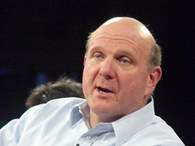 Today, Microsoft announced in a press release and the release of a letter from CEO Steve Ballmer to Microsoft employees, that Ballmer will retire from Microsoft as soon as a new CEO can be found, sometime within the next twelve months. Ballmer, who joined the company in 1980 as Microsoft’s 30th employee, became CEO in 2000, but took full control of the company when Chairman and founder Bill Gates stepped down as Chief Software Architect in 2006 to concentrate on his Foundation and charitable work. Since then, the technology world has changed significantly, with Microsoft falling from a prominent position as maker of the software that drove the computing industry to a world now where Google, Apple, and increasingly, Amazon have taken over the lead, leaving Microsoft with a slumping PC market and a trailing position in mobile and tablet computing, having failed to make inroads with Windows Phone or Microsoft Surface.
Today, Microsoft announced in a press release and the release of a letter from CEO Steve Ballmer to Microsoft employees, that Ballmer will retire from Microsoft as soon as a new CEO can be found, sometime within the next twelve months. Ballmer, who joined the company in 1980 as Microsoft’s 30th employee, became CEO in 2000, but took full control of the company when Chairman and founder Bill Gates stepped down as Chief Software Architect in 2006 to concentrate on his Foundation and charitable work. Since then, the technology world has changed significantly, with Microsoft falling from a prominent position as maker of the software that drove the computing industry to a world now where Google, Apple, and increasingly, Amazon have taken over the lead, leaving Microsoft with a slumping PC market and a trailing position in mobile and tablet computing, having failed to make inroads with Windows Phone or Microsoft Surface.
The timing of the move is interesting, coming just a few months after Ballmer announced a restructuring of the senior leadership of the company, moving to a more “functional” style of management and moving a younger set of leaders into prominent positions. Tami Reller, Julie Larson-Green, Tony Bates from Skype, Satya Nadella, Qi Lu, and others all rose prominently in recent years and now hold senior leadership positions, with a new emphasis on Microsoft as a “devices and services” company. Still, with all the upper management moves, it’s still business as usual for the rank and file of the company, at least so far. No one has been downsized, no jobs or departments have been eliminated, and no major programs have been cut, moves that would seem to be if not necessary, then desirable in transforming Microsoft into a company capable of competing in a post-PC world.
Perhaps Ballmer was unwilling to make those moves, and chose to allow a successor to take the next steps, or perhaps news that activist investors ValueAct, who recently acquired one percent of Microsoft’s stock and are pushing for a seat on the Board of Directors in order to force Microsoft’s hand in decisions like the fate of Ballmer and the future of Xbox and Bing, had an effect on Ballmer’s decision making.
It has been becoming more and more clear that Ballmer’s stated objective of staying on at Microsoft through 2017 or so wasn’t in the best interests of the company, and making the move now, before the “Devices and Services” vision in fully baked in but after the company has received at least a bit of a shakeup with the reorg, may be as good a time as any for the CEO to step down.
Of course, the next obvious question is who will replace Ballmer? Bill Gates has said repeatedly that he’s not coming back, and he’s probably not the right person for the job, anyway. Members of the senior leadership team are in prime positions to assume control, although except for Tony Bates and Qi Lu, most all of them are Microsoft “lifers”, and wouldn’t be able to breathe new life into the company, something that it could use, frankly.
One person we’ve always had our eye on is Stephen Elop, currently the head of Nokia and a longtime “Softie” before that. He’s gained experience running a company from top to bottom at Nokia, and has done a good job of moving the company forward. We would doubt that he would leave Nokia to come back, as that could put the only hope Microsoft has for Windows Phone, that is the health of Nokia, in peril. However, there were those rumors of a Microsoft acquisition of Nokia a while ago, so a return of Elop may not be entirely out of the question.
If nothing else, the Ballmer retirement announcement gets Microsoft back in the headlines, and ensures that Microsoft watching will be highly entertaining as the search for a CEO develops. Interesting times!

